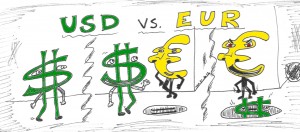Anatole Koetsky writes: The US dollar is hitting new 12-year highs almost daily, while the euro seems to be plunging inexorably to below dollar parity. Currency movements are often described as the most unpredictable of all financial variables; but recent events in foreign-exchange markets seem, for once, to have a fairly obvious explanation – one that almost all economists and policymakers accept and endorse.
French President François Hollande, for one, has ecstatically welcomed the plunging euro: “It makes things nice and clear: one euro equals a dollar,” he told an audience of industrialists. But it is when things seem “nice and clear” that investors should question conventional wisdom. A strong dollar and a weak euro is certainly the most popular bet of 2015. So is there a chance that the exchange-rate trend may already be overshooting?
In one sense, the conventional explanation of the recent euro-dollar movement is surely right. The main driving force clearly has been monetary divergence, with the Federal Reserve tightening policy and the European Central Bank maintaining rock-bottom interest rates and launching quantitative easing. But how much of this divergence is already priced in? The answer depends on how many people either are unaware of the interest-rate spread or do not believe that it will widen very far.
Last year, many investors questioned the ECB’s ability to launch a bond-buying program in the face of German opposition, and many others doubted the Fed’s willingness to tighten monetary policy, because doing so could choke off the US economic recovery. That is why the euro was still worth almost $1.40 a year ago – and why I and others expected the euro to fall a long way against the dollar.
But the scope for dollar-bullish or euro-bearish surprises is much narrower today. Does anyone still believe that the US economy is on the brink of recession? Or that the Bundesbank has the power to overrule ECB President Mario Draghi’s policy decisions?
With so much of the monetary divergence now discounted, perhaps we should focus more attention on the other factors that could influence currency movements in the months ahead.
On the side of a stronger dollar and weaker euro, there seem to be three possibilities. One is that the Fed could raise interest rates substantially faster than expected. Another is that investors and corporate treasurers could become increasingly confident and aggressive in borrowing euros to convert into dollars and take advantage of higher US rates. Finally, Asian and Middle Eastern central banks or sovereign wealth funds could take advantage of the ECB’s bond-purchase program to sell increasing proportions of their German, French, or Italian debt and reinvest the proceeds in higher-yielding US Treasury securities.
Four factors could push the dollar-euro exchange rate the other way.
1. If the dollar continues to rise, US economic activity and inflation will weaken. In that case, the Fed, instead of raising interest rates faster than expected, will probably become more dovish.
2. There must be serious doubts about whether Asian and Middle Eastern governments will in fact want to shift more reserves into dollars, especially if this means converting the euros they have acquired since 2003 at a loss and far below their purchasing power parity.
3. The euro’s downward trend against the dollar may not last much longer because there is the trade imbalance between the US and Europe.
The implication is that hundreds of billions of dollars of capital will have to flow annually to the US from Europe just to maintain the present euro-dollar exchange rate.
4. While higher US interest rates will attract some investors, others will move away from the dollar if the combination of a more competitive euro, the ECB’s enormous monetary stimulus, and an easing of fiscal pressures in France, Italy, and Spain generates a genuine economic recovery in Europe.
What, then, can strike a balance between the opposing forces operating on the euro-dollar exchange rate? No one can say for sure.

